
Abul Wafa is an impact crater located near the lunar equator on the far side of the Moon, named after the Persian mathematician and astronomer Abu al-Wafa' Buzjani. To the east are the crater pair Ctesibius and Heron. In the northeast lies the larger crater King, and to the southwest is Vesalius.

Auzout is a lunar impact crater that is located to the southeast of the Mare Crisium, near the eastern limb of the Moon. It is named after French astronomer Adrien Auzout."Auzout (crater)". Gazetteer of Planetary Nomenclature. USGS Astrogeology Research Program. Attached to the southern rim is the smaller crater van Albada. To the east-northeast is the large Condorcet. This crater is not especially notable, although it does possess a central mountain. This crater is designated 'Azout' in some sources.
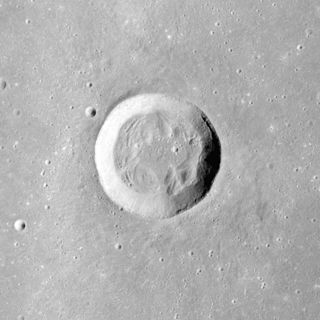
Bessel is a small lunar impact crater that is located in the southern half of the Mare Serenitatis. The crater was named after the German astronomer Friedrich Wilhelm Bessel in 1935. Despite its small size, this is the largest crater to lie entirely within the mare. It lies to the north-northeast of the crater Menelaus.

Bonpland is the remains of a lunar impact crater that is attached to the walled plain Fra Mauro to the north and Parry to the east. The intersection of their rims forms a three-pointed mountainous rise. To the southeast is the small crater Tolansky. Bonpland lies on the eastern edge of Mare Cognitum. It is named after Aimé Bonpland, a French explorer and botanist.

Delisle is a small lunar impact crater in the western part of the Mare Imbrium. It was named after French astronomer Joseph-Nicolas Delisle. It lies to the north of the crater Diophantus, and just to the northwest of the ridge designated Mons Delisle. Between Delisle and Diophantus is a sinuous rille named Rima Diophantus, with a diameter of 150 km. To the northeast is another rille designated Rima Delisle, named after this crater.
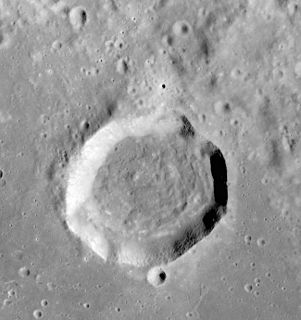
Vitruvius is a small lunar impact crater that lies on the northern edge of the Mare Tranquillitatis. To the east is the crater Gardner, and to the northeast is Fabbroni. To the north-northwest is the elongated Mons Vitruvius mountain, and beyond is the valley where the Apollo 17 mission landed.

Alfraganus is a small lunar impact crater that lies in the rugged highland region to the southwest of the Mare Tranquillitatis. It is named after Persian astronomer Alfraganus. Northwest of Alfraganus is the crater Delambre, and to the south is the irregular Zöllner. The rim of Alfraganus is circular and retains a sharp edge that has not received a significant amount of wear due to subsequent impacts. The interior floor is roughly half the diameter of the crater rim.

Armiński is a small lunar impact crater that is located on the far side of the Moon, to the northeast of the large walled basin Gagarin. To the northwest of Armiński is the crater Beijerinck, and to the southeast lies Cyrano.

Auwers is a small lunar impact crater located in the Montes Haemus mountain range at the south edge of Mare Serenitatis. It is named after German astronomer Arthur Auwers. It lies southeast of the crater Menelaus. The irregular rim of Auwers has a gap at the north-northwest edge, which allowed lava flows to reach the crater floor and flood the interior.
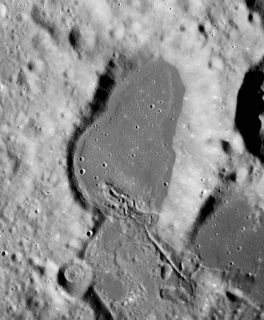
Bowditch is a lunar impact crater that lies on the far side of the Moon, just beyond the eastern limb. It is located on a region of the lunar surface that is brought into view due to libration, but at such times the area is viewed from the edge and so not much detail can be observed. It lies just to the north of the small Lacus Solitudinis lunar mare, between the craters Titius to the southwest and Perel'man to the east-northeast.

Bergman is a small lunar impact crater that is located on the far side of the Moon. It was named after Swedish astronomer Torbern O. Bergman. It is located on the interior floor of the walled plain Mendeleev, and is attached to the edge of the inner wall to the northwest. On the same walled basin are the craters Moissan to the south and Richards to the west. The rim of Bergman is roughly circular, and the formation is generally bowl-shaped. The western half of the interior floor is covered with a slope of scree, leaving a small level floor on the eastern side.

Brunner is a lunar impact crater that is located along the eastern limb of the Moon, to the southeast of the Mare Smythii. At this location the crater is viewed from the edge, and so it is not possible to see much detail from the Earth. The visibility of this formation is also affected by libration. The crater lies to the southwest of the walled plain Hirayama, and to the east of the elongated crater Houtermans.

Wildt is a small lunar impact crater that is located near the eastern limb of the Moon. It was named after German-American astronomer Rupert Wildt. It was previously designated Condorcet K. The nearest named crater is Condorcet to the west-northwest. The crater is circular and bowl-shaped, with a small floor at the midpoint of the sloping interior walls. It has not received significant wear from subsequent impacts.
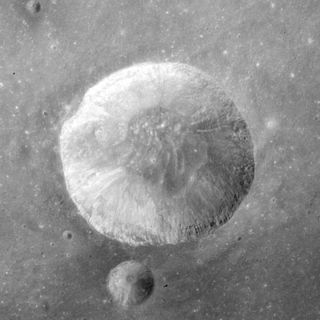
Carmichael is a lunar impact crater that is located along the eastern edge of the Sinus Amoris, in the northeastern quadrant of the Moon's near side. Its diameter is 20 km. It was named after American psychologist Leonard Carmichael. It lies within a couple of crater diameters south-southwest of the smaller crater Hill. Further to the east-northeast is the prominent crater Macrobius. Carmichael was designated Macrobius A before being given its current name by the IAU.
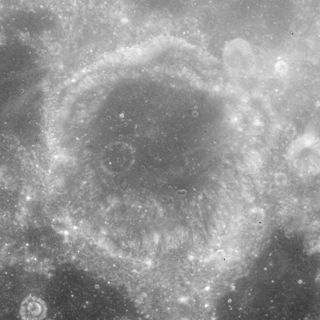
Dubyago is a lunar impact crater that lies in the eastern limb of the Moon. It was named after Russian astronomers Dmitry Dubyago and Alexander Dubyago. It appears significantly foreshortened when viewed from the Earth. It lies along the southern shore of the Mare Undarum, to the southeast of the crater Firmicus.

Firmicus is a lunar impact crater that lies in the eastern part of the Moon's near side, so that from Earth it appears oval in shape due to foreshortening. It is, however, very nearly circular. The crater is located to the west of the Mare Undarum, and northeast of the similar-sized crater Apollonius. To the north of Firmicus are the craters van Albada and Auzout. Attached to its northwest rim is the Lacus Perseverantiae, a miniature lunar mare.

Daubrée is a lunar impact crater that is located to the southwest of the Mare Serenitatis, just to the west-southwest of the crater Menelaus in the Montes Haemus range. The small lunar mare Lacus Hiemalis lies along the southwest rim of Daubrée. The crater was named after French geologist Gabriel A. Daubrée. It was previously designated Menelaus S.
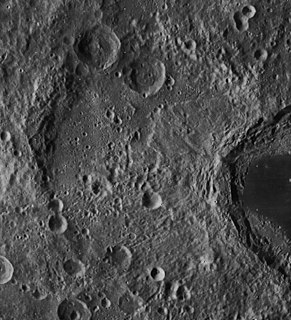
Fermi is a large lunar impact crater of the category named a walled plain. It was named after Italian-American physicist and Nobel laureate Enrico Fermi. It lies on the far side of the Moon and can not be viewed from the Earth. Thus this feature must be viewed from an orbiting spacecraft.

Ibn Firnas is a lunar impact crater on the far side of the Moon. In 1976 it was named after Abbas Ibn Firnas, a polymath from Andalucia who, in the 9th century, devised a chain of rings that could be used to simulate the motions of the planets and stars.

Diderot is a small lunar impact crater on the far side of the Moon. It lies within the southwestern interior floor of the huge walled plain Fermi, about midway between the basin midpoint and the southwest rim. The crater is saucer-shaped, with smaller craters located just to the northwest and the north. The inner wall is narrower along the eastern side, and has a pair of ridges along the southern face. This crater is otherwise unremarkable.

























